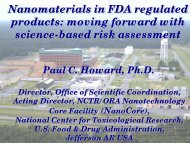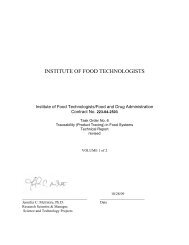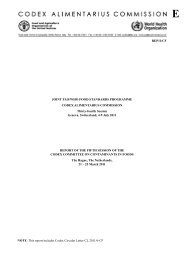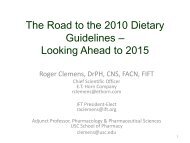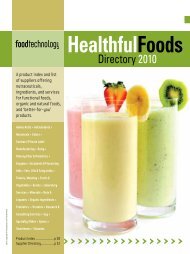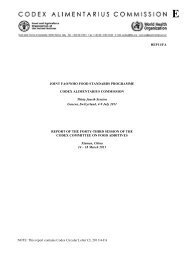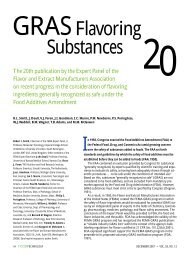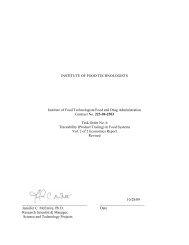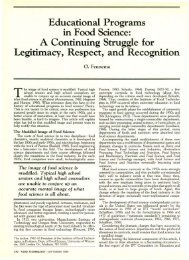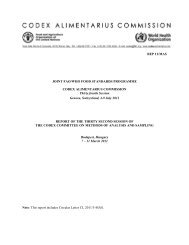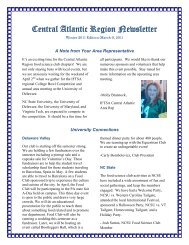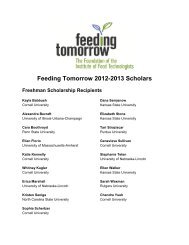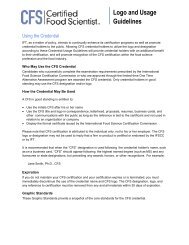Biological Agents and Factors Affecting Decontamination
Biological Agents and Factors Affecting Decontamination
Biological Agents and Factors Affecting Decontamination
Create successful ePaper yourself
Turn your PDF publications into a flip-book with our unique Google optimized e-Paper software.
<strong>Biological</strong> <strong>Agents</strong><br />
And<br />
<strong>Factors</strong> <strong>Affecting</strong> <strong>Decontamination</strong><br />
Bruce R. Cords, Ph.D.<br />
Ecolab Inc.
<strong>Biological</strong> <strong>Agents</strong> of Concern<br />
B. anthracis Anthrax<br />
Variola major<br />
Smallpox<br />
Yersinia pestis<br />
Plague<br />
Vibrio cholera<br />
Cholera<br />
Filovirdia<br />
Ebola<br />
Aphthovirus<br />
Foot & Mouth Disease<br />
Botulinum Toxin<br />
Botulism
Resistance to Biocides<br />
PRIONS<br />
BACTERIAL SPORES<br />
PROTOZOA CYST/OOCYSTS<br />
(e.g. Crytosporidium)<br />
MYCOBACTERIUM<br />
NON-ENVELOPED VIRUSES<br />
FUNGI<br />
VEGETATIVE BACTERIA<br />
LIPID-ENVELOPED VIRUSES
Relative Biocidal Activity<br />
Bacterial Spores<br />
Mycobacterium<br />
Non-enveloped Viruses<br />
Peroxyacids, glutaraldehyde,<br />
formaldehyde, chlorine dioxide,<br />
ethylene oxide<br />
Mycobacterium<br />
Non-enveloped Viruses<br />
Fungi<br />
Phenolics, Iodophors,<br />
Hypochlorites<br />
Vegetative Bacteria<br />
Enveloped Viruses<br />
Quaternary Ammonium<br />
Compounds, Organic Acids<br />
* There Are Exceptions!
Antimicrobial Tests<br />
(Required for EPA Registration)<br />
Product Test Required Organisms<br />
General disinfectant<br />
AOAC Use<br />
Dilution<br />
S. cholerasuis ATCC 10708<br />
S. aureus ATCC 6538<br />
Hospital disinfectant AOAC Use<br />
Dilution<br />
S. cholerasuis ATCC 10708<br />
S. aureus ATCC 6538<br />
P. aeruginosa ATCC 1542<br />
Sporicidal<br />
AOAC<br />
Sporicidal<br />
B. subtilis ATOC 19659<br />
Cl. sporogenes ATCC 3584
Food Contact Surface Sanitizer<br />
AOAC Germicidal Detergent Sanitizer Test<br />
99 ml Sanitizer<br />
Use-Solution<br />
25ºC<br />
Add 1 ml of E.coli<br />
or S.aureus<br />
(minimum of 7.5 x 10 7<br />
CFU/ml)<br />
30 second<br />
Contact<br />
Time<br />
0<br />
15<br />
30<br />
Required<br />
Efficacy:<br />
99.999% Kill in<br />
30 seconds at<br />
25ºC<br />
Enumerate<br />
Survivors<br />
Neutralize<br />
1 ml
Suggested Surrogates<br />
Agent<br />
Variola major (Smallpox)<br />
Yersinia pestis (Plague)<br />
Vaccinia virus<br />
Surrogate<br />
Yersinia pseudotuberculosis<br />
Bacillus anthracis (Anthrax) B. subtilis B. cereus<br />
B. globigii<br />
Foot-<strong>and</strong>-Mouth Disease Virus ?<br />
Norwalk Virus<br />
Feline calicivirus
Regulatory Hurdle<br />
− EPA does not allow real or implied claims<br />
for any infectious agent that is not stated<br />
on the product label.<br />
− Very few commercial products have been<br />
tested against the c<strong>and</strong>idate biological<br />
agents.
Legal Issues<br />
1) It is a violation of Federal law to use an EPA registered<br />
product in a manner inconsistent with its labeling.<br />
– Solution strength must be according to label<br />
– Applications must be on the label<br />
2) It is a violation of Federal law for a manufacturer to<br />
make real or implied claims for efficacy against<br />
organisms which are not on the label.<br />
– Creates problems when we encounter:<br />
• FMDV<br />
• Anthrax<br />
• Norwalk<br />
• SARS<br />
• Avian Influenza H5N1
Anthrax/Bacillus anthracis<br />
−<br />
−<br />
−<br />
−<br />
No products carry label claims (some have<br />
crisis exemption)<br />
Cutaneous, pulmonary, <strong>and</strong><br />
gastrointestinal transmitted by aerosols<br />
<strong>and</strong> on environmental surfaces<br />
Infectious dose - 5-10,000 spores (inhaled)<br />
Effective agents (published literature)<br />
– .25%-.50% (2500-5000 ppm) Peroxyacetic Acid<br />
– 2% (20,000 ppm) Glutaraldehyde<br />
– 4% (40,000 ppm) Formaldehyde<br />
– 1% (10,000 ppm) Sodium Hypochlorite
Smallpox/Variola Major<br />
Complex Coat<br />
−<br />
−<br />
−<br />
−<br />
No products carry label claims<br />
Transmitted through aerosols, contact<br />
with infected person, <strong>and</strong> environmental<br />
surfaces<br />
Low infectious dose - a few virons<br />
Effective agents (published literature)<br />
– 1% (10,000 ppm) Sodium Hypochlorite<br />
– 2% (20,000 ppm) Glutaraldehyde<br />
– 2% (20,000 ppm) Formaldehyde
Levels of <strong>Decontamination</strong> Somewhat<br />
Dependent on Infectious Dose<br />
Smallpox<br />
Anthrax<br />
A few virons can<br />
induce disease.<br />
Infectious dose<br />
(inhaled) may be<br />
10,000 spores<br />
– Smallpox decontamination to 100<br />
virons/m 2 not acceptable<br />
– Anthrax decontamination to 100<br />
spores/m 2 probably a safe level
Plague/Yersinia pestis<br />
− No products carry label claims<br />
− Transmitted as an aerosol through<br />
respiratory droplets or plague-infected<br />
fleas. Organism does not survive more<br />
than a few hours outside the host.<br />
− Infectious dose - 50-1500<br />
− Effective agents (published literature)<br />
– 1% (10,000 ppm) Sodium Hypochlorite<br />
– 70% Ethanol<br />
– 2% (20,000 ppm) Glutaraldehyde<br />
– Many general disinfectants
Cholera/Vibrio cholera<br />
− No products carry label claims<br />
− Transmitted by contact <strong>and</strong> in water <strong>and</strong><br />
food contaminated with excreta from<br />
infection individuals<br />
− Infectious dose 10 6<br />
− Effective agents<br />
– General disinfectants
Ebola/Filovirida<br />
Enveloped RNA Virus<br />
− No products carry label claims<br />
− Transmitted by contact with infected<br />
individuals or their blood/secretions.<br />
Environmental?<br />
− Low infectious dose<br />
− Effective agents (published literature)<br />
– 2% (20,000 ppm) Sodium Hypochlorite<br />
– 2% (20,000 ppm) Glutaraldehyde<br />
– .5% (5,000 ppm) Peracetic Acid<br />
– 1% (10,000 ppm) Formaldehyde
Foot & Mouth<br />
Disease/ Apthovirus<br />
Non Enveloped RNA Virus<br />
− Some products carry Label Claims<br />
− Transmitted by aerosols, environmental<br />
surfaces <strong>and</strong> direct contact between animals<br />
− Low infectious dose<br />
− Effective agents (published literature <strong>and</strong><br />
product approvals)<br />
– .03% (300 ppm) Peracetic Acid<br />
– .1% (10,000 ppm) Peroxymonosulphate<br />
– .05% (500 ppm) Sodium Hypochlorite<br />
– Other products (Ministry of Agriculture Fisheries<br />
<strong>and</strong> Food; U.K.)
Is SARS a Potential Bioterrorism<br />
Agent?<br />
1. Available? Yes<br />
2. Culturable? Yes<br />
3. Infective? Highly<br />
4. Deliverable? Unknown<br />
5. <strong>Decontamination</strong>? Likely to be<br />
susceptible to common disinfectants
Lessons Learned from the Anthrax Case<br />
1. We were not prepared for<br />
decontamination (e.g. Hart Building).<br />
2) It took three treatments with ClO 2 to<br />
achieve adequate results.<br />
3) Many items were destroyed as opposed<br />
to decontaminated.<br />
4) Ambulance chasers with “cure-alls” were<br />
abundant (e.g. spores vs. vegetative).
Bacillus anthracis<br />
Spores vs. Vegetative Cells<br />
Peracetic Acid 5-log<br />
reduction<br />
Spores<br />
Vegatative<br />
2,500 ppm for 30 min.<br />
150 ppm for 30 sec.
<strong>Factors</strong> Contributing to Failure<br />
of <strong>Decontamination</strong><br />
Disinfectant/Biocide:<br />
− Selection of biocide not effective against<br />
infectious agent<br />
− Biocide too dilute<br />
− Insufficient contact time<br />
− Temperature too low*<br />
− Relative humidity too low<br />
− (gaseous disinfectants)
<strong>Factors</strong> Contributing To Failure<br />
of <strong>Decontamination</strong><br />
Environmental <strong>Factors</strong>:<br />
− Presence of organic matter*<br />
− Inactivation of QAC’s by residual soaps<br />
<strong>and</strong> detergents<br />
− Incorrect application/coverage<br />
− Inadequate treatment of water supply<br />
− “Wettability” of surface
All Sanitizers Are NOT Created Equal<br />
Reduced Temperature Sanitizer Efficacy<br />
70 o F. Well Water (250 ppm)<br />
30 Seconds<br />
L<br />
o<br />
g<br />
6<br />
5<br />
R 4<br />
e<br />
d 3<br />
u 2<br />
c<br />
t<br />
1<br />
i 0<br />
o 0.20% 0.35% 0.13% 0.26% Acid<br />
n Peracetic Acid Organic Acid Anionic<br />
Quat<br />
Iodophor Chlorine<br />
S. aureus E. coli
All Sanitizers Are NOT Created Equal<br />
Reduced Temperature Sanitizer Efficacy<br />
55 o F. Well Water (250 ppm)<br />
30 Seconds<br />
L<br />
o<br />
g<br />
6<br />
5<br />
R 4<br />
e<br />
d 3<br />
u 2<br />
c<br />
t<br />
1<br />
i 0<br />
o 0.20% 0.35% 0.13% 0.26% Acid<br />
n Peracetic Acid Organic Acid Anionic<br />
Quat<br />
Iodophor Chlorine<br />
S. aureus E. coli
L<br />
o<br />
g<br />
R<br />
e<br />
d<br />
u<br />
c<br />
t<br />
i<br />
o<br />
n<br />
6<br />
5<br />
4<br />
3<br />
2<br />
1<br />
0<br />
All Sanitizers Are NOT Created Equal<br />
Reduced Temperature Sanitizer Efficacy<br />
40 o F. Well Water (250 ppm)<br />
30 Seconds<br />
0.20% 0.35% 0.13% 0.26% Acid<br />
Peracetic Acid Organic Acid Anionic<br />
S. aureus E. coli<br />
Quat Iodophor Chlorine
All Sanitizers Are NOT Created Equal<br />
Reduced Temperature Sanitizer Efficacy<br />
40 o F. Well Water (250 ppm)<br />
2 Minutes<br />
L<br />
o<br />
g<br />
6<br />
R<br />
e<br />
d<br />
u<br />
c<br />
t<br />
i<br />
o<br />
n<br />
5<br />
4<br />
3<br />
2<br />
1<br />
0<br />
0.20% 0.35% 0.13% 0.26% Acid<br />
Peracetic Acid Organic Acid Anionic<br />
Quat Iodophor Chlorine<br />
S. aureus E. coli
Effect of Temperature Organic Load<br />
<strong>and</strong> Concentration on Disinfectant<br />
Activity<br />
Quaternary Disinfectant:<br />
(Log Reduction for P. aeruginosa)<br />
QUAT<br />
1000 ppm<br />
5 minutes<br />
20°C 10°C<br />
x0.5 x1.0 x2.0 x0.5 x1.0 x2.0<br />
.03% F P P F F P<br />
BSA<br />
.3% F P P F F F<br />
BSA<br />
Taylor et al 1999<br />
P (Pass) = > 5 log reduction<br />
F (Fail) = < 5 log reduction
Effect of Temperature Organic Load<br />
<strong>and</strong> Concentration on Disinfectant<br />
Activity<br />
Peracetic Acid Disinfectant:<br />
(Log Reduction for P. aeruginosa)<br />
Peracetic<br />
Acid<br />
300 ppm<br />
5 minutes<br />
20°C 10°C<br />
x0.5 x1.0 x2.0 x0.5% x1.0 x2.0<br />
.03% P P P P P P<br />
BSA<br />
.3% F P P F P P<br />
BSA<br />
Taylor et al 1999<br />
P (Pass) = > 5 log reduction<br />
F (Fail) = < 5 log reduction
Treatment of a 48 Hour<br />
Biofilm of Pseudomonas aeruginosa*<br />
70<br />
60<br />
1 Minute Contact Time<br />
50<br />
40<br />
30<br />
20<br />
10<br />
0<br />
80 ppm 160 ppm 320 ppm<br />
Peracetic/Organic Acid Peracetic Acid Chlorine<br />
*Fatemi <strong>and</strong> Frank. 1999. Journal of Food Protection. Vol. 62 (761-765)
Effect of Relative Humidity on<br />
Sporicidal Activity (B. globigii) of<br />
Formaldehyde<br />
Log<br />
Concentration RH Temp Reduction Time<br />
400 mg/m 3 30% 25°C 1 22’<br />
400 mg/m 3 98% 25°C 1 9’<br />
Ref: Emerging Infectious Disease Vol 9 No 6 p. 625
Effect of Relative Humidity on<br />
Sporicidal Activity (B. subtilis v<br />
niger) of Peracetic Acid Vapor<br />
Log<br />
Concentration RH Temp Reduction Time<br />
1mg/L 80% RT >5 log 10’<br />
1mg/L 60% RT >4 log 10’<br />
1mg/L 40% RT >3 log 10’<br />
Ref: Emerging Infectious Disease Vol 9 No 6 p. 626
Inactivation Of Bacillus spp. By Boiling In<br />
Tap Water<br />
Initial log<br />
CFU/ml<br />
After 5’<br />
Boiling<br />
C UNC C UNC<br />
B. anthracis 4.95 4.92 0 2.01<br />
(sterne)<br />
B. cereus 4.62 4.59 0 1.46<br />
(commercial)<br />
B. cereus 4.54 4.76 0 0.48<br />
ATCC 9592<br />
B. thuringensis 4.63 4.46 0 1.47<br />
ATCC 35646<br />
C = Covered<br />
UNC = Uncovered<br />
Temp above surface: C = 98.9°C UNC = 77.3°C<br />
Ref: Emerging Infectious Disease Vol 10 No 10 2004
National Center for Food Protection<br />
<strong>and</strong> Defense<br />
Study No: 910F2376745 – Ecolab<br />
Development of Time/Temperature Concentration<br />
Matrix for Inactivation of Infectious Bioterrorism<br />
<strong>Agents</strong> by Chemical Biocides<br />
Student:<br />
Hilgren – Ecolab<br />
Co-Advisors: Swanson – Ecolab<br />
Diez – University of Minnesota
Bacillus<br />
Spores<br />
General Method<br />
Food Soil<br />
• Egg Yolk Emulsion<br />
• Whole Milk<br />
• Flour Slurry<br />
8.8% protein<br />
3.5% fat<br />
7.6% starch<br />
Spore/soil mixture dried on<br />
stainless steel carrier<br />
Carrier immersed in c<strong>and</strong>idate<br />
biocide for 10 minutes
Impact of Food Soil on Inactivation<br />
of B. cereus spores by Peroxyacetic<br />
Acid (Preliminary Results)<br />
Conditions = 10 minute exposure<br />
20°C<br />
B. cereus ATCC 10987<br />
Log Reduction<br />
5,000 ppm 10,000 ppm<br />
No Soil >7.0 >7.0<br />
Whole Milk 1.5 4.0<br />
Egg Yolk 2.0 4.0<br />
Flour 2.0 7.0<br />
Ref: Ecolab, NCFPD Project
Impact of Food Soil <strong>and</strong> Temperature on<br />
Inactivation of B. cereus Spores by<br />
Peroxyacetic Acid (Preliminary Results)<br />
Conditions =<br />
10 minute exposure<br />
10,000 ppm Peroxyacetic acid<br />
B. cereus ATCC #10987<br />
Log Reduction<br />
10°C 20°C 30°C<br />
No Soil 6.0 >7.0 >7.0<br />
Whole Milk 1.5 4.0 >7.0<br />
Egg Yolk 2.0 4.0 5.5<br />
Flour 1.5 7.0 7.0<br />
Ref: Ecolab, NCFPD Project
Impact of Food Soil on Inactivation<br />
of B. cereus spores by Sodium<br />
Hypochlorite (Preliminary Results)<br />
Conditions = 10 minute exposure<br />
20°C<br />
B. cereus ATCC 10987<br />
Log Reduction @ 50,000 ppm<br />
No Soil >7.0<br />
Whole Milk 1.2<br />
Egg Yolk 1.9<br />
Flour >7.0<br />
Note: Flour @ 1,000 ppm - >7.0 log reduction<br />
Ref: Ecolab, NCFPD Project
Other Results to Date:<br />
− Quarternary Ammonium Chloride<br />
− Not effective at 75,000 ppm (7.5%), 20°C<br />
− Normal disinfection level = 200-800 ppm<br />
− Iodophor<br />
− Not effective at 19,000 ppm (1.9%), 20°C<br />
− Normal disinfection level = 25 ppm<br />
− Acidified Sodium Chlorite<br />
− Somewhat effective<br />
− Egg yolk <strong>and</strong> milk results not as good as flour<br />
− Hydrogen Peroxide<br />
− Effective at 25-30%; 20°C<br />
− Not effective at 10°C<br />
− Mixed Peroxyacid System<br />
− Results similar to peroxyacetic acid
Future Testing to Include:<br />
− B. anthracis (nonvirulent strain)<br />
− Yersinia Pestis



